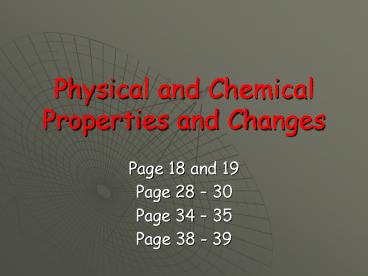Physical and Chemical Properties and Changes - PowerPoint PPT Presentation
1 / 16
Title:
Physical and Chemical Properties and Changes
Description:
Physical and Chemical Properties and Changes Page 18 and 19 Page 28 30 Page 34 35 Page 38 - 39 Page 18 - 19 Chemical Properties of Matter When one substance ... – PowerPoint PPT presentation
Number of Views:226
Avg rating:3.0/5.0
Title: Physical and Chemical Properties and Changes
1
Physical and Chemical Properties and Changes
- Page 18 and 19
- Page 28 30
- Page 34 35
- Page 38 - 39
2
Page 18 - 19
- Chemical Properties of MatterWhen one substance
can interact with another, the characteristic
behaviour is called a chemical property. Ie.
Dynamite explodes when exposed to a flame and
mixes with oxygen in the air.
3
Vocabulary
- Chemical PropertyA chemical property describes
the behaviour of a substance as it becomes a new
substance. - Combustibility
- Combustibility is a property that describes the
ability of a substance to react with oxygen to
produce carbon dioxide, water and energy.
Combustible is flammable non-combustible is
nonflammable!
4
- Reaction with acid
- Another chemical property of matter is reaction
with acid. For example, when magnesium metal is
added to acid, it produces bubbles of gas and the
metal disappears. Limestone is identified by
its reaction to acid bubbles of gas are
produced when they come in contact. - Metals and Nonmetals
- Matter can be grouped as metals and nonmetals.
Mixtures of metals are alloys. Examples are
braces, cooking pots and airplanes.
5
Physical and Chemical Changes
- ARE NOT THE SAMEasPhysical and Chemical
Properties - we have studied so far.
6
A burning candle what happens?
- As the candle burns, the wax melts (a solid
becomes a liquid), and then it hardens (a liquid
becomes a solid). These are physical changes. - The wax also combusts producing heat and light.
This chemical change involves the wax becoming
carbon dioxide, water and energy.
7
Physical and Chemical Changes(Not the same as
Phys. and Chem. Properties)
- Physical Change The substance involved remains
the same, even though it may change state or
form. - Ex. Pour melted chocolate on ice cream.
- It still tastes the same because the particles
have not changed, it just hardened (changed
state) because the ice cream was cool. - Most physical changes are easy to reverse.
8
- Chemical Changes The original substance is
changed into one or more different substances
that have different properties. - Examples
- Burning, Cooking, Rusting
- The formation of water from hydrogen and oxygen.
- The formation of rust from iron and oxygen.
- Chemical changes are difficult to reverse.
9
- There are usually clues that a chemical change
has happened - A new colour appears.
- Heat or light is given off.
- Bubbles of gas are given off.
- A solid material (called a precipitate) forms in
a liquid. - The change is difficult to reverse.
10
Assignment
- 1. Copy Table 2, page 30 in your notebook.
- 2. Read pages 28-30 and on page 30 answer
questions 1-4. Copy the questions and the
answers into your notebook.
11
Page 30 questions 1-4
- 1. Explain how a physical change differs from a
chemical change. - Chemical changes involve production of a new
substance with new properties. No new substances
are produced in physical changes.
12
- 2. a) Garbage rotting
- chemical
- b) Cutting up carrots
- physical
- c) A silver spoon turning black
- chemical
- d) Making tea from tea leaves
- physical
- e) Bleaching a stain
- chemical
- f) Boiling an egg
- chemical
13
Question 3
- Changes occur more quickly at high temperatures.
Putting candles together tends to concentrate
heat more and the candles will be at a higher
temperature. - For emergencies, non-dripping and non-smoking
candles should be kept on hand. - (or battery operated)
14
Question 4
- Evaporation, mixing, and condensation are
physical changes. - Combustion, catalytic conversion and rusting are
chemical changes.
15
16
Sample Chemical Changes (Always involve the
production of a new substance.)
- Ex. 1 H O ? H2O (water)
- gas gas liquid
- Reactants Left side Products Right
side - Ex. 2
- C 2O ? CO2 (carbon dioxide)
- Ex. 3
- 6C 12H 6O ? C6H12O6 (sugar)
- Ex. 4
- 3C 8H ? C3H8 (Propane)

